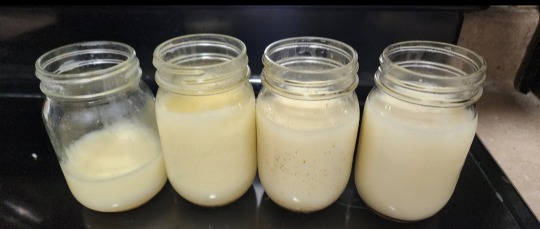#making tallow
Explore tagged Tumblr posts
Text



Vrijdag 21 juni 2024... van het zelfgesmolten rundsvet mijn eerste shampoo-zeep gemaakt
#summer#21 june#summer 2024#diy#easy#easy diy#enjoyingthemoment#homemade#2024#crafts#soap#shampoo#shampoo bar#tallow#making tallow#homemade soap#back to basics#natural products#shampoo bars#render tallow#inspiration From Scratch Farmstead#using up some oils
4 notes
·
View notes
Text
Buying a house in the UK is officially insane. My solicitor was like "Oh BTW don't worry about the Feudal Burdens section of the contract" and im like "The. Sorry. What now?" and she's like "Oh the bit about Sir William Wallace Hozier (1895) and all his heirs owning the rights to any coal or ironstone extraction beneath your land. And having to pay him 17 pounds 10 shillings per annum" like how tf am i not supposed to worry about that. it says right here if i don't pay Hozier his shillings by Martinmas he'll take my sheep. And that's not even getting into the secret tunnel
#i say 'house'... tis a 300sqft flat lmaoooo#apparently i'm not allowed to take up tallow candle-making; leather tanning; or open a distillery. Sad!
237 notes
·
View notes
Text
love when there's like a video of how instant ramen is manufactured and there's text on the screen like "I ain't ever eating it again! [puking emoji]" Did you think it was specially prepared? Did you think some asian grandma made all of it herself? No, it's made in a factory kitchen. Don't kid yourself, you knew that. But forced to confront it you balk at the idea, get a fucking grip.
#tbh factory kitchens are pretty neat#I like how they take raw ingredients like tallow and make soup it's cool
12 notes
·
View notes
Text
Pure golden grassfed beef tallow, ready for soap making
9 notes
·
View notes
Note
same amount of tallow please
welcome back 🕯️tallow fans🕯️to another concentrated dose of tallow! check out the merch store to get your own "100% tallow bitch" shirt







20 notes
·
View notes
Text
Nov 14 2024
I finally found a store with beef fat! :D
Where i live we don't exactly have butchers, and a butcher tends to be more like a corner quick grocer with a counter of preseasoned raw for grill meats (no plain cuts or fat, organs etc)
I've been looking so i can use the fat for cooking and soapmaking.
I got 6.8 lbs of raw beef fat this time.

Since it's big chunks and renders better in smaller peices I ut the fat up into squares like so,

Now you can render on the stove top, rendering just takes ages.
I prefer and suggest a crock pot, set it on low and let it just do it's thing overnight at least. The next morning you can start siphoning the tallow from the crock.
I ended up with 3 and about a half a pint.

Not enough for soaping, but next time i know to ask for more if they'll save it.
Now, this tallow could be rendered again to get it very creamy white (none of those lil brown spots) but since I'll be using this up quick for food cooking I'm just gonna leave it as is.
Re render is as easy as cleaning the leftover "fat-meat" bits out of the crock or pot and pouring in to rerender up to a day. Repour while fine filtering. Cool and go from there.
Now how can I use this, One might ask. Particularly if your not familiar with using fat instead of say spray on, Olive oil, etc.
Honestly using tallow is rather just as easy as using other fats, easier once you learn how to use it It has a high smoke/burn point as well.
We use it for frying eggs, chicken, potatoes and more,
I use it in place of butter, crisco ( Soybean Oil, Fully Hydrogenated Palm Oil, Palm Oil, and a few more) and vegetable oil (which did you know is soybean oil and corn oil mix?).
For making bread, cakes, cookies and more at home. (Including soap if i have enough)
🐄 🌱Happy Homesteading and Cooking! 🌱 🐄
#homesteading#thestudentfarmer#self sufficient living#studentfarmer#self sufficiency#food#garden#gardening#low waste#beef fat#tallow#render fat#urban homesteading#frugal cooking#austerity cooking#ways to use food#use it all#use it wisely#depression cooking#nose to tail cooking#farm to table#soap making#home cooking#less ingredients#whole foods#healthy eating#human right to clean food
6 notes
·
View notes
Text
How To Make Soap From Deer Tallow
youtube
Please like and subscribe if you enjoy!
#buckskin bill#skills#deer tallow#tallow#soap#tallow soap#soap making#soapmaking#use every part of the deer
2 notes
·
View notes
Text
I Love My Wife
So, like, my wife has this odd skin condition where her skin turns all scaly and rough so I end up having to come up with a lot of potions and unguents to treat its manifestations and learning a lot about skin and physical chemistry. Ive lesrned thst she resoinds incredibly well to fat, its a comooete game changer.
So today I'm sharing part 1 of my miraculous lotion recipe.
Ingredient 1. Fat.

You gotta find high quality fats. There's a lot of woo woo "science" going along with this science. But what you don't want is the poisons and hormones the cow has been bathing its tissues in ti be harmful to your body and so you want high quality fat from high quality cows. To that end you need fat from around the liver and internal organs from grass fed cows.
#woowoosciencealert #1
Grass fed cows have higher quality meat and higher quality fat and they're not inundated with cortisol most of their lives. It's not a splurge, Doctor's Orders.
You have to render the fat out. I use a wet render method found below.
Wet rendering is preferable to dry rendering because dry rendering tends to flavor the oil and leave it smelling extra beefy. My wife isn't a slab of meat (I treat her like a piece of meat sometimes).
A wet render boils the fat in water until it separates from the associated tissue a dry render (which I will use for cooking fats) just heats that mass of flesh up in a pan. I also throw some salt and baking powder into my wet render to help deodorize.
Wet render with the Insta Pot is easy. I alternate between slow cook and soup modes. At some point I whisk the tissue in the pot to break it up unto the smallest constituent pieces. After 4 or so hours I strain the resulting liquid into a suitable container.

I then throw it into the freezer in order to solidify the fat for ease of separation.

Once frozen I will take the fat off, rinse the bottom off and store it in preparation for the next phase.
Stay tuned for the next phase.
#tallow#wet render#marriage#Slaving Over A Hot Stove#Husband Of The Year#Don't Know How To Make Titles
2 notes
·
View notes
Text
Super Nanny
2 notes
·
View notes
Text
anyways, it always drives me nuts when I see ppl going 'but it's not fat it's juice' in regards to the liquid that's formed when you cook meat (esp when they tack on 'don't pour it down the sink' in the same breath. buddy you don't get it both ways).
like, yeah it's the juices and drippings from meat, but there IS fat in it. that's why it congeals into a solid mass upon cooling. that's why it's greasy and oily to the touch. that's why you can see the oil and water in the pan cause they don't mix.
it is LITERALLY fat.
if it was just juice then pouring it down the drain wouldn't be an issue. but it's not just 'juice'
#it being fat is not a bad thing i s2g#and as i pointed out in my previous post#that's literally how you make tallow/lard
4 notes
·
View notes
Text
I don't get it either, obligatory I am an omnivore, but I'll sometimes be a "fake vegetarian" cuz I love vegetarian options and am picky about meat. I also just love eggs. I'm a big time believer that everyone deserves delicious food, no matter their dietary restrictions, convictions and choices. ESPECIALLY comfort foods.
(i hijack this post for my vegan tamales Texas pasty lady imposter syndrome)
I really love the challenge of making vegan/vegetarian options. My favorite is tamales cuz I think they lend themselves well to meat free/plant based if you know what you're doing. They're also inherently gluten free. People can get weird about vegan tamales, but my cousins and my friend's vegan gf mama love em.
I kinda stall out on fillings tho cuz I feel like I'm missing obvious choices. I don't really like using meat substitute/plant based cheese products cuz they're kinda expensive and hard to find where I live. I would rather go extra steps to make a mushroom chorizo or something like that. But IIII am not vegan and know nothing of the desire for substitutions for dearly missed foods like cheese.
Vegan/Vegetarian tamales I do make are chile sweet potato, bean, and cream cheese jalapeno. The possibilities with tamale fillings are endless, but I keep being timid. Nopalito/cactus is an option that I've never cooked with cuz I'm chicken. Rajas/pepper strips are a common tamale filling also that's meatless. I've heard of people putting carrots in them, too. My internet research has suuuucked on this topic.
If I was in the city, it'd prolly be easier to find ideas from what people are making, emphasis on latiné vegans, but alas. I have a rival/coworker who spent time in vegan kitchens in Austin, but he's one of those people who make it weird that tamales gotta have meat. Even tho neither of us have any literal skin in the authenticity game (we pasty) we just Texan. I'm extra inauthentic, NOT vegan AND pasty. Idk what it's like for actual vegans coming up in Hispanic/Latiné families, but I wanna know what they think makes good vegan tamales.
There's also SO MANY WAYS people make tamales. I'm self conscious about having zero skin in the game, so I always tell people "this is just how IIIII learned" omitting other Central and South American countries, just Mexico is HUGE with tons of regional differences and THEN those all trickle thru the US and what's available and convenient from place to place family to family etc
There's absolutely gotta be big money vegan tamales in California, but my mom in law who taught me the craft calls it "Baja food" so I wanna stick to what's local, but I'm getting desperate at this point as tamale season gets closer.
Part of the reason I try to make good vegetarian food even though I’m not vegetarian is because of the one week my dad was convinced he was gonna go vegan.
You know what he made for dinner that whole week? Steamed vegetables, rice, and canned beans. All unseasoned. Technically a nutritionally complete meal. It tasted awful.
How could a man usually so good at cooking forget literally all of that when faced with the possibility of making vegan food?
I thought there had to be a better way. And it turns out there is. Vegetarian food doesn’t taste bad. Cartoons that depict vegetarians eating a singular leaf for a meal have ruined us. A lot of stuff that meat eaters eat in everyday life is technically vegetarian or easily made vegetarian. Why when faced with one restriction do so many people forget every single egg sandwich or apple pie they’ve ever eaten?
#tamale season is basically the holidays from what i gather#its also deer season for meeee im SO ready for venison tamales and gumbo and boudin and jerky and and ane#i had to tell myself NO to making menudo on my day off cuz it got cold#my dumbass gave it all away but if im lucky there might be a brick in the back of my freezer#i have an uncle who cant do red meat so a poultry based menudo has been a tantalizing simmering challenge ive thought about#vegan#vegetarian#cw hunting#dietary restrictions#tamales#texan#texas vegan#the price of ojas/corn husks for tamales is KILLING ME#im in TX and i see bags for $9#ARE U SERIOUS#im so glad i get restaurant perks for beef tallow cuz fuck these gd grocery games#i just made a batch of tamales with scrap beef from my restaurant#i rendered off a shitload of tallow and had a gallon bag of beef left and was like well shit I GOTTA make tamales outta this beautiful meat#i made it with a chile sauce like u add to menudo which my family doesn't usually do but i know is really common for beef tamale filling#deat tumblr if youre vegan or vegetarian and like tamales what do u want in them please o please
9K notes
·
View notes
Text
We're doing a giveaway on IG/FB of our new tallow collection! Pop on over to enter if you're so inclined.

https://www.instagram.com/reel/DJ2tuiUOu-K/?igsh=cm82a2U4a2p0cWFo
instagram
#soap making#cold process soap#homesteading#apothecary#myempireofdirt#slowliving#beef tallow#Instagram
0 notes
Photo

Beef tallow fell out of favor in the 1990s, but it's back big time. It's popping up in restaurants and home kitchens, and on TikTok, where health influencers debate its benefits. This versatile animal fat has a long history as a cornerstone of the human diet. While we aren't advocating you add beef tallow to your beauty routine as some on social media are, we spoke to chefs and a nutritionist to get their take on why beef tallow is worth having in your kitchen, and the best ways to use it in your cooking. Just What Is Beef Tallow? A rendered form of beef fat, beef tallow is known for its rich flavor and high smoke point of 400 degrees Fahrenheit. Traditionally, it was used in European and American kitchens for frying, roasting, and even pastry making, where it would give everything from flaky pie crusts to hand-cut fries a deep, savory taste and a crispy texture. If you lived through the 1980s, you may recall the rich, savory scent that greeted you when you entered a McDonald's; that was beef tallow, which the chain used to fry its burgers and fries in up until the 1990s. The smell of cooking with beef tallow is a little like Sunday pot roast in grandma's oven. The Composition and Health Benefits of Beef Tallow Tallow is mainly made up of saturated fat, specifically stearic and palmitic acids, and some monounsaturated fat, primarily oleic acid, which is also found in olive oil, explains Kalyn True, RDN, LD, Bariatric Dietitian at Memorial Hermann Health System. Nutritionally, besides being rich in saturated fats and fat-soluble vitamins like A, D, and K, beef tallow contains no trans fats when properly rendered. "Beef tallow is similar to butter in that it's high in saturated fat, but it's dairy-free and a bit more stable at high cooking temperatures," says True. "Compared to olive or vegetable oils, which are higher in unsaturated fats, tallow is more traditional and unprocessed, but it doesn't offer the same heart-healthy benefits as extra virgin olive oil." Is Beef Tallow Healthy? While True wouldn't call beef tallow "heart-healthy" in the same way as olive oil or avocado oil, she doesn't think it is off limits. She understands the big draw of its being stable when used for cooking at high temperatures, capable of adding a rich, savory flavor, and acknowledges it is an alternative for those looking to avoid "ultra-processed" ingredients. "There was a time when all saturated fat was lumped together and blamed for heart disease, but science has evolved," True says. "Now, we know that the type of saturated fat, the amount you eat, and the overall context of your diet all matter. Tallow on its own isn't necessarily harmful, especially when used occasionally as part of a balanced diet. It's about the big picture, not just one ingredient." Why Cooks Like Beef Tallow Less processed: Increasingly, the draw of beef tallow is that it is less processed than some other cooking oils. That was a big benefit for chef Johan Jensen, co-owner of Whitecrest Eatery in Stonington Borough, Connecticut, who, after initially experimenting with it from a culinary perspective, was attracted to beef tallow to cook cleaner for his kids. High smoke point: An oil's smoke point is the temperature at which the oil will burn, lose flavor, and produce harmful compounds. The beneficial nutrients in the oil will also break down. Beef tallow has a relatively high smoke point, higher than olive oil, which means it can be used for high heat cooking like roasting. Flavor: Beef tallow tastes amazing, says Konig. He explains that he and his co-founder, Ben Johnson, have made a lot of fries. "Through all of our experimenting, fries cooked in beef tallow really stood out from the pack. They crisp up beautifully on the outside, take on a rich golden color, and develop a meaty, umami flavor that is incredibly satiating." Jensen says he still cooks with olive oil and avocado oil, but also enjoys the flavor beef tallow adds to dishes. 6 Ways to Use Beef Tallow If you're ready to start experimenting with beef tallow, start by swapping it for other high-heat cooking oils. You'll use roughly the same amount as you would for another oil. Besides fries, here are a few other ways to use it. Burgers After fries, the first thing that comes to mind for beef tallow is, well, meat. You could sear meat with beef tallow or use it to cook a burger. "It's the flavor," Jensen says. "It's going back to that good old burger. Cooking a piece of meat in its own fat, that's beautiful, and if you're using that whole animal and its flavor, you smell it." Fat(tier) Fish Jensen says any of the darker, fatty fishes, such as mackerel, play nicely with beef tallow. "Basically, anything you would slap on the grill." But beef tallow does not work as well for all types of fish; he recommends not using it for more delicate types, Roasting Vegetables Beef tallow could be used for roasting vegetables at high heat, says True. Frying Eggs A simple way to start experimenting with beef tallow is use it to fry an egg says Konig. Beef tallow's high smoke point means you can get your fry pan nice and hot without burning the fat. Hello, easy, breakfast. Fajita Bowl "One of my go-to dishes is a simple one-pan fajita bowl," Konig says. "I like to sauté thinly sliced peppers and onions in beef tallow until they're soft and slightly caramelized. Then I add a pound of ground beef right into the same pan, let it all cook together, and serve it over rice with some avocado on the side. It's quick, flavorful, and the tallow adds a rich depth that ties everything together." Fried Pastries Jensen says he was skeptical when one of his chefs at Whitecrest used beef tallow to cook doughnuts but that the result "was so good." Now, they use beef tallow for any fried pastry-type dishes. Keep in mind that your kitchen might get a beef smell when you're cooking with beef tallow and that if you are used to cooking with vegetable oils, which are designed to be flavorless, the beef tallow will add flavor. You will likely want to keep a neutral oil on hand in addition to beef tallow. "Once you start experimenting with beef tallow, you'll find yourself reaching for it all the time," Konig says. Use a variety of cooking fats: None of our experts suggests moving over to beef tallow to the exclusion of other fats. True suggests including a mix of fats from animal and plant sources to give yourself flexibility in the kitchen and support overall health. She says that each oil can have its place and value in a moderate and inclusive diet. Where to Buy Beef Tallow and How to Store It While professional chefs like Konig and Jensen go through a lot of beef tallow, it is possible for home chefs to buy it on a smaller scale. "When I'm shopping for home use. I always try to find tallows that are 100 percent grass-fed and ideally stored in glass. Some of our favorite tallows come from Lineage Provisions or Foxhollow Farm, which you can buy online and get shipped to you," Konig says. According to True, the key from a nutritional standpoint is that you want tallow from grass-fed, pasture-raised beef whenever possible. "Truly, this is going to mean a slightly better fatty acid profile, reflected by more sustainable farming practices. Ideally, choose a brand that's minimally processed and free from additives; the tallow should just be pure rendered fat with nothing else added," Storing Beef Tallow You can keep beef tallow on the counter; It's shelf-stable, which makes it easy and convenient to use in everyday cooking. If you're using small amounts for sautéing or roasting, it gets incorporated into the dish like any other fat. But if you're deep frying in tallow, you can save it in a glass container and reuse it. Just make sure to let it cool first. How to Make Beef Tallow at Home If you're feeling ambitious, you could even render your own beef tallow at home. Here's how, according to Jensen. Chop beef fat into small pieces and slowly simmer it over low heat in a heavy pot or slow cooker until it melts and separates from any solids.Strain the liquid fat through a fine mesh sieve or cheesecloth into a jar, then let it cool and solidify for storage. Source link
0 notes
Text
Also are you sure you trust RFK Jr to tackle things that are actually dangerous? Dude thinks vaccines are unhealthy. One of the things he wants to rid our diets of is seed oils, including canola. The research suggesting these cause inflammation is mixed at best, and there is very little evidence that his solution - replacing them wholesale with animal fats like beef tallow and butter - leads to any positive health outcomes. But producing them requires “processing” therefore they are processed foods and bad.
it’s so crazy to see people say “yeah I don’t agree with RFK JR on everything but at least he’s going to tackle the poison in our food!!!!!¡” I would rather eat red 40 for breakfast lunch and fucking dinner than see what the Trump administration will do to food in America.
#rfk jr#ftr I am also not saying you need to avoid butter or even beef tallow#everything in moderation#(although beef tallow is fucking hard to find,I wanted some to make hot pot base and could not find it,so good luck eating too much of it)
2K notes
·
View notes
Photo

Beef tallow fell out of favor in the 1990s, but it's back big time. It's popping up in restaurants and home kitchens, and on TikTok, where health influencers debate its benefits. This versatile animal fat has a long history as a cornerstone of the human diet. While we aren't advocating you add beef tallow to your beauty routine as some on social media are, we spoke to chefs and a nutritionist to get their take on why beef tallow is worth having in your kitchen, and the best ways to use it in your cooking. Just What Is Beef Tallow? A rendered form of beef fat, beef tallow is known for its rich flavor and high smoke point of 400 degrees Fahrenheit. Traditionally, it was used in European and American kitchens for frying, roasting, and even pastry making, where it would give everything from flaky pie crusts to hand-cut fries a deep, savory taste and a crispy texture. If you lived through the 1980s, you may recall the rich, savory scent that greeted you when you entered a McDonald's; that was beef tallow, which the chain used to fry its burgers and fries in up until the 1990s. The smell of cooking with beef tallow is a little like Sunday pot roast in grandma's oven. The Composition and Health Benefits of Beef Tallow Tallow is mainly made up of saturated fat, specifically stearic and palmitic acids, and some monounsaturated fat, primarily oleic acid, which is also found in olive oil, explains Kalyn True, RDN, LD, Bariatric Dietitian at Memorial Hermann Health System. Nutritionally, besides being rich in saturated fats and fat-soluble vitamins like A, D, and K, beef tallow contains no trans fats when properly rendered. "Beef tallow is similar to butter in that it's high in saturated fat, but it's dairy-free and a bit more stable at high cooking temperatures," says True. "Compared to olive or vegetable oils, which are higher in unsaturated fats, tallow is more traditional and unprocessed, but it doesn't offer the same heart-healthy benefits as extra virgin olive oil." Is Beef Tallow Healthy? While True wouldn't call beef tallow "heart-healthy" in the same way as olive oil or avocado oil, she doesn't think it is off limits. She understands the big draw of its being stable when used for cooking at high temperatures, capable of adding a rich, savory flavor, and acknowledges it is an alternative for those looking to avoid "ultra-processed" ingredients. "There was a time when all saturated fat was lumped together and blamed for heart disease, but science has evolved," True says. "Now, we know that the type of saturated fat, the amount you eat, and the overall context of your diet all matter. Tallow on its own isn't necessarily harmful, especially when used occasionally as part of a balanced diet. It's about the big picture, not just one ingredient." Why Cooks Like Beef Tallow Less processed: Increasingly, the draw of beef tallow is that it is less processed than some other cooking oils. That was a big benefit for chef Johan Jensen, co-owner of Whitecrest Eatery in Stonington Borough, Connecticut, who, after initially experimenting with it from a culinary perspective, was attracted to beef tallow to cook cleaner for his kids. High smoke point: An oil's smoke point is the temperature at which the oil will burn, lose flavor, and produce harmful compounds. The beneficial nutrients in the oil will also break down. Beef tallow has a relatively high smoke point, higher than olive oil, which means it can be used for high heat cooking like roasting. Flavor: Beef tallow tastes amazing, says Konig. He explains that he and his co-founder, Ben Johnson, have made a lot of fries. "Through all of our experimenting, fries cooked in beef tallow really stood out from the pack. They crisp up beautifully on the outside, take on a rich golden color, and develop a meaty, umami flavor that is incredibly satiating." Jensen says he still cooks with olive oil and avocado oil, but also enjoys the flavor beef tallow adds to dishes. 6 Ways to Use Beef Tallow If you're ready to start experimenting with beef tallow, start by swapping it for other high-heat cooking oils. You'll use roughly the same amount as you would for another oil. Besides fries, here are a few other ways to use it. Burgers After fries, the first thing that comes to mind for beef tallow is, well, meat. You could sear meat with beef tallow or use it to cook a burger. "It's the flavor," Jensen says. "It's going back to that good old burger. Cooking a piece of meat in its own fat, that's beautiful, and if you're using that whole animal and its flavor, you smell it." Fat(tier) Fish Jensen says any of the darker, fatty fishes, such as mackerel, play nicely with beef tallow. "Basically, anything you would slap on the grill." But beef tallow does not work as well for all types of fish; he recommends not using it for more delicate types, Roasting Vegetables Beef tallow could be used for roasting vegetables at high heat, says True. Frying Eggs A simple way to start experimenting with beef tallow is use it to fry an egg says Konig. Beef tallow's high smoke point means you can get your fry pan nice and hot without burning the fat. Hello, easy, breakfast. Fajita Bowl "One of my go-to dishes is a simple one-pan fajita bowl," Konig says. "I like to sauté thinly sliced peppers and onions in beef tallow until they're soft and slightly caramelized. Then I add a pound of ground beef right into the same pan, let it all cook together, and serve it over rice with some avocado on the side. It's quick, flavorful, and the tallow adds a rich depth that ties everything together." Fried Pastries Jensen says he was skeptical when one of his chefs at Whitecrest used beef tallow to cook doughnuts but that the result "was so good." Now, they use beef tallow for any fried pastry-type dishes. Keep in mind that your kitchen might get a beef smell when you're cooking with beef tallow and that if you are used to cooking with vegetable oils, which are designed to be flavorless, the beef tallow will add flavor. You will likely want to keep a neutral oil on hand in addition to beef tallow. "Once you start experimenting with beef tallow, you'll find yourself reaching for it all the time," Konig says. Use a variety of cooking fats: None of our experts suggests moving over to beef tallow to the exclusion of other fats. True suggests including a mix of fats from animal and plant sources to give yourself flexibility in the kitchen and support overall health. She says that each oil can have its place and value in a moderate and inclusive diet. Where to Buy Beef Tallow and How to Store It While professional chefs like Konig and Jensen go through a lot of beef tallow, it is possible for home chefs to buy it on a smaller scale. "When I'm shopping for home use. I always try to find tallows that are 100 percent grass-fed and ideally stored in glass. Some of our favorite tallows come from Lineage Provisions or Foxhollow Farm, which you can buy online and get shipped to you," Konig says. According to True, the key from a nutritional standpoint is that you want tallow from grass-fed, pasture-raised beef whenever possible. "Truly, this is going to mean a slightly better fatty acid profile, reflected by more sustainable farming practices. Ideally, choose a brand that's minimally processed and free from additives; the tallow should just be pure rendered fat with nothing else added," Storing Beef Tallow You can keep beef tallow on the counter; It's shelf-stable, which makes it easy and convenient to use in everyday cooking. If you're using small amounts for sautéing or roasting, it gets incorporated into the dish like any other fat. But if you're deep frying in tallow, you can save it in a glass container and reuse it. Just make sure to let it cool first. How to Make Beef Tallow at Home If you're feeling ambitious, you could even render your own beef tallow at home. Here's how, according to Jensen. Chop beef fat into small pieces and slowly simmer it over low heat in a heavy pot or slow cooker until it melts and separates from any solids.Strain the liquid fat through a fine mesh sieve or cheesecloth into a jar, then let it cool and solidify for storage. Source link
0 notes
Photo

Beef tallow fell out of favor in the 1990s, but it's back big time. It's popping up in restaurants and home kitchens, and on TikTok, where health influencers debate its benefits. This versatile animal fat has a long history as a cornerstone of the human diet. While we aren't advocating you add beef tallow to your beauty routine as some on social media are, we spoke to chefs and a nutritionist to get their take on why beef tallow is worth having in your kitchen, and the best ways to use it in your cooking. Just What Is Beef Tallow? A rendered form of beef fat, beef tallow is known for its rich flavor and high smoke point of 400 degrees Fahrenheit. Traditionally, it was used in European and American kitchens for frying, roasting, and even pastry making, where it would give everything from flaky pie crusts to hand-cut fries a deep, savory taste and a crispy texture. If you lived through the 1980s, you may recall the rich, savory scent that greeted you when you entered a McDonald's; that was beef tallow, which the chain used to fry its burgers and fries in up until the 1990s. The smell of cooking with beef tallow is a little like Sunday pot roast in grandma's oven. The Composition and Health Benefits of Beef Tallow Tallow is mainly made up of saturated fat, specifically stearic and palmitic acids, and some monounsaturated fat, primarily oleic acid, which is also found in olive oil, explains Kalyn True, RDN, LD, Bariatric Dietitian at Memorial Hermann Health System. Nutritionally, besides being rich in saturated fats and fat-soluble vitamins like A, D, and K, beef tallow contains no trans fats when properly rendered. "Beef tallow is similar to butter in that it's high in saturated fat, but it's dairy-free and a bit more stable at high cooking temperatures," says True. "Compared to olive or vegetable oils, which are higher in unsaturated fats, tallow is more traditional and unprocessed, but it doesn't offer the same heart-healthy benefits as extra virgin olive oil." Is Beef Tallow Healthy? While True wouldn't call beef tallow "heart-healthy" in the same way as olive oil or avocado oil, she doesn't think it is off limits. She understands the big draw of its being stable when used for cooking at high temperatures, capable of adding a rich, savory flavor, and acknowledges it is an alternative for those looking to avoid "ultra-processed" ingredients. "There was a time when all saturated fat was lumped together and blamed for heart disease, but science has evolved," True says. "Now, we know that the type of saturated fat, the amount you eat, and the overall context of your diet all matter. Tallow on its own isn't necessarily harmful, especially when used occasionally as part of a balanced diet. It's about the big picture, not just one ingredient." Why Cooks Like Beef Tallow Less processed: Increasingly, the draw of beef tallow is that it is less processed than some other cooking oils. That was a big benefit for chef Johan Jensen, co-owner of Whitecrest Eatery in Stonington Borough, Connecticut, who, after initially experimenting with it from a culinary perspective, was attracted to beef tallow to cook cleaner for his kids. High smoke point: An oil's smoke point is the temperature at which the oil will burn, lose flavor, and produce harmful compounds. The beneficial nutrients in the oil will also break down. Beef tallow has a relatively high smoke point, higher than olive oil, which means it can be used for high heat cooking like roasting. Flavor: Beef tallow tastes amazing, says Konig. He explains that he and his co-founder, Ben Johnson, have made a lot of fries. "Through all of our experimenting, fries cooked in beef tallow really stood out from the pack. They crisp up beautifully on the outside, take on a rich golden color, and develop a meaty, umami flavor that is incredibly satiating." Jensen says he still cooks with olive oil and avocado oil, but also enjoys the flavor beef tallow adds to dishes. 6 Ways to Use Beef Tallow If you're ready to start experimenting with beef tallow, start by swapping it for other high-heat cooking oils. You'll use roughly the same amount as you would for another oil. Besides fries, here are a few other ways to use it. Burgers After fries, the first thing that comes to mind for beef tallow is, well, meat. You could sear meat with beef tallow or use it to cook a burger. "It's the flavor," Jensen says. "It's going back to that good old burger. Cooking a piece of meat in its own fat, that's beautiful, and if you're using that whole animal and its flavor, you smell it." Fat(tier) Fish Jensen says any of the darker, fatty fishes, such as mackerel, play nicely with beef tallow. "Basically, anything you would slap on the grill." But beef tallow does not work as well for all types of fish; he recommends not using it for more delicate types, Roasting Vegetables Beef tallow could be used for roasting vegetables at high heat, says True. Frying Eggs A simple way to start experimenting with beef tallow is use it to fry an egg says Konig. Beef tallow's high smoke point means you can get your fry pan nice and hot without burning the fat. Hello, easy, breakfast. Fajita Bowl "One of my go-to dishes is a simple one-pan fajita bowl," Konig says. "I like to sauté thinly sliced peppers and onions in beef tallow until they're soft and slightly caramelized. Then I add a pound of ground beef right into the same pan, let it all cook together, and serve it over rice with some avocado on the side. It's quick, flavorful, and the tallow adds a rich depth that ties everything together." Fried Pastries Jensen says he was skeptical when one of his chefs at Whitecrest used beef tallow to cook doughnuts but that the result "was so good." Now, they use beef tallow for any fried pastry-type dishes. Keep in mind that your kitchen might get a beef smell when you're cooking with beef tallow and that if you are used to cooking with vegetable oils, which are designed to be flavorless, the beef tallow will add flavor. You will likely want to keep a neutral oil on hand in addition to beef tallow. "Once you start experimenting with beef tallow, you'll find yourself reaching for it all the time," Konig says. Use a variety of cooking fats: None of our experts suggests moving over to beef tallow to the exclusion of other fats. True suggests including a mix of fats from animal and plant sources to give yourself flexibility in the kitchen and support overall health. She says that each oil can have its place and value in a moderate and inclusive diet. Where to Buy Beef Tallow and How to Store It While professional chefs like Konig and Jensen go through a lot of beef tallow, it is possible for home chefs to buy it on a smaller scale. "When I'm shopping for home use. I always try to find tallows that are 100 percent grass-fed and ideally stored in glass. Some of our favorite tallows come from Lineage Provisions or Foxhollow Farm, which you can buy online and get shipped to you," Konig says. According to True, the key from a nutritional standpoint is that you want tallow from grass-fed, pasture-raised beef whenever possible. "Truly, this is going to mean a slightly better fatty acid profile, reflected by more sustainable farming practices. Ideally, choose a brand that's minimally processed and free from additives; the tallow should just be pure rendered fat with nothing else added," Storing Beef Tallow You can keep beef tallow on the counter; It's shelf-stable, which makes it easy and convenient to use in everyday cooking. If you're using small amounts for sautéing or roasting, it gets incorporated into the dish like any other fat. But if you're deep frying in tallow, you can save it in a glass container and reuse it. Just make sure to let it cool first. How to Make Beef Tallow at Home If you're feeling ambitious, you could even render your own beef tallow at home. Here's how, according to Jensen. Chop beef fat into small pieces and slowly simmer it over low heat in a heavy pot or slow cooker until it melts and separates from any solids.Strain the liquid fat through a fine mesh sieve or cheesecloth into a jar, then let it cool and solidify for storage. Source link
0 notes